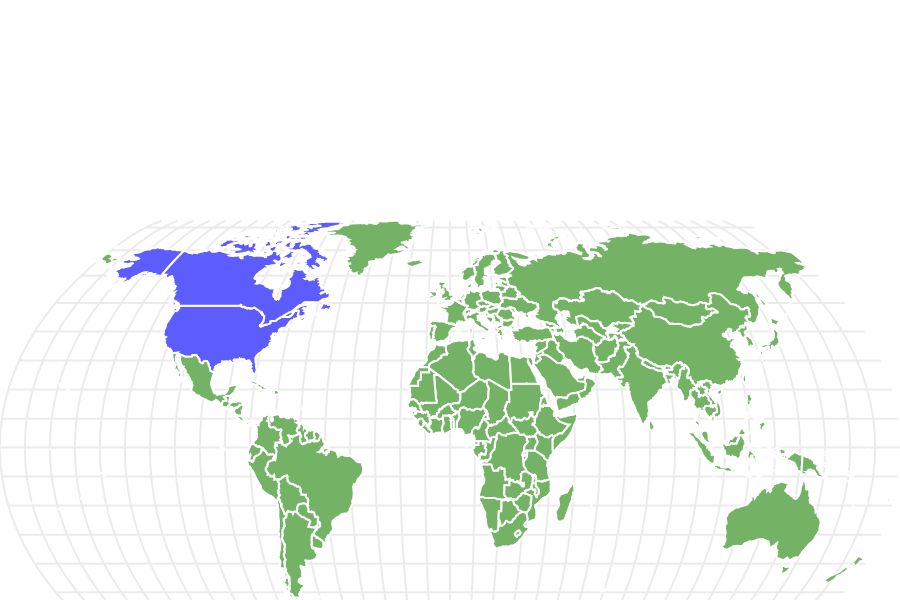Queen Snake
Queen snakes have armor-like scales on the top of their head
Advertisement
Queen Snake Scientific Classification
- Kingdom
- Animalia
Queen Snake Facts
- Prey
- Freshly moulted crayfish
- Group Behavior
- Solitary
- Fun Fact
- Queen snakes have armor-like scales on the top of their head
- Gestation Period
- 2-3 months
View all of the Queen Snake images!
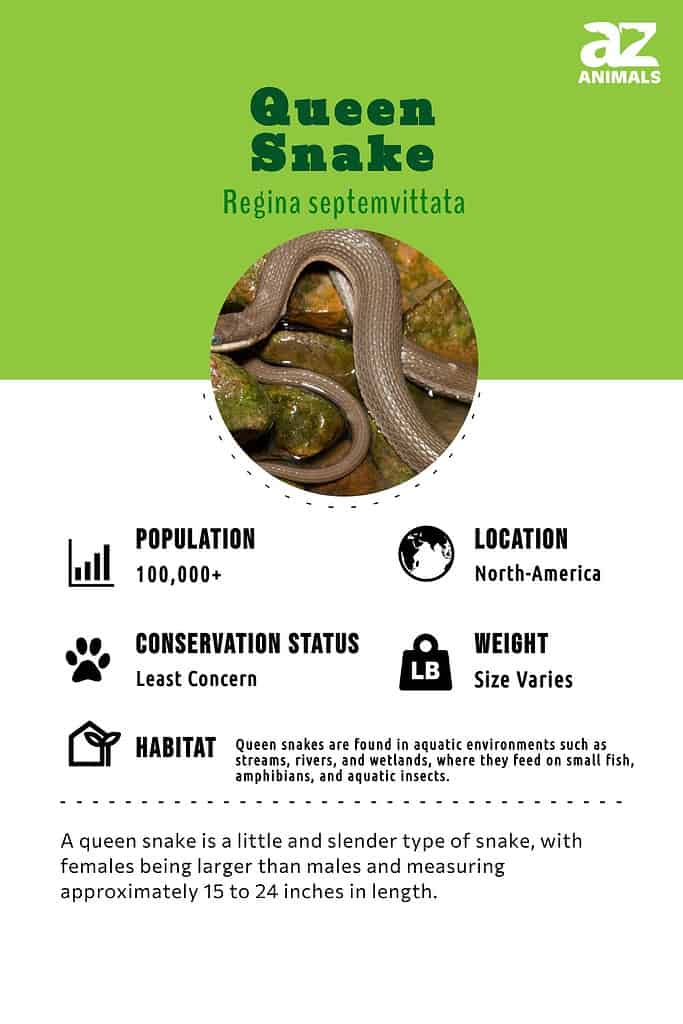
Queen Snake Summary
“Queen snakes are very important for their role in the food web, controlling the population of crayfish while also being a food source for many land, water, and winged creatures.”
Queen snakes are docile, nonvenomous, and semiaquatic snakes found in temperate regions of the United States and southern Ontario, Canada located east of the Mississippi River, the largest river in the U.S.
Their habitat must include stony streams within a watershed where they can hunt their primary prey, crayfish.
Although they are most active during the day, they sometimes hunt and explore at night.
4 Amazing Queen Snake Facts
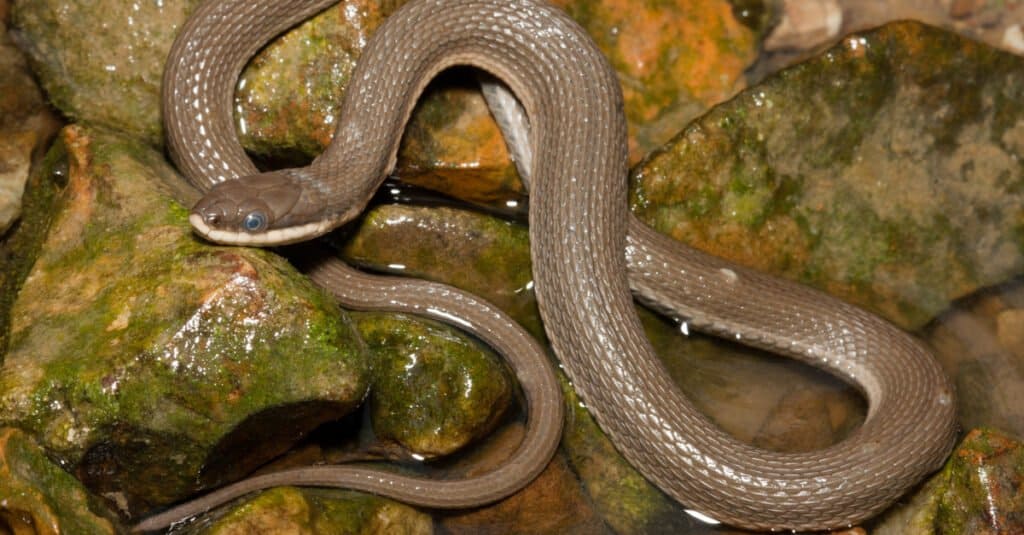
©Nathan A Shepard/Shutterstock.com
- Queen snakes have armor-like scales on the top of their head and multiple rows of tough scales beneath their chins to safeguard their head when crawling under heavy rocks and on rough surfaces
- The lifespan of a queen snake living in captivity is up to 19 years!
- These semiaquatic snakes play a major role in controlling the crayfish population with 90% of their diet made up of the freshwater crustaceans
- Being nonvenomous and easy to handle, these snakes make great pets!
Evolution and Origins
From the Great Lakes to middle Louisiana, the eastern US’s Piedmont and mountainous terrain are home to queen snakes. This species is widespread in our area’s mountains and some Piedmont areas, and its distribution extends into the Coastal Plain along various river drainages.
The queen snake’s chin has numerous rows of thicker scales, and its narrow head has nine huge, plate-like scales on top. Because of the snake’s feeding behavior of chasing its prey under boulders, this adaption serves as protection. The majority of other colubrids also have circular pupils in their eyes.
The queen snake is a thin and petite type of snake that has a maximum length of 1.5 to 2 feet or 15 to 24 inches. In general, female queen snakes are larger than males. Although the majority of these snakes measure less than 24 inches, the species’ lengthiest specimens have been known to grow up to 37 inches long from nose to tail tip.
Different Types of Queen Snakes
Here is a list of the different types of queen snakes:
- Banded Water Snake
- Brown Queen Snake
- Diamondback Water Snake
- Leather Snake
- Moon Snake
- North American Seven-banded Snake
- Olive Water Snake
- Pale Snake
- Queen Water Snake
- Seven-striped Water Snake
- Striped Water Snake
- Three-striped Water Snake
- Willow Snake
- Yellow-bellied Snake
Where to Find Queen Snakes
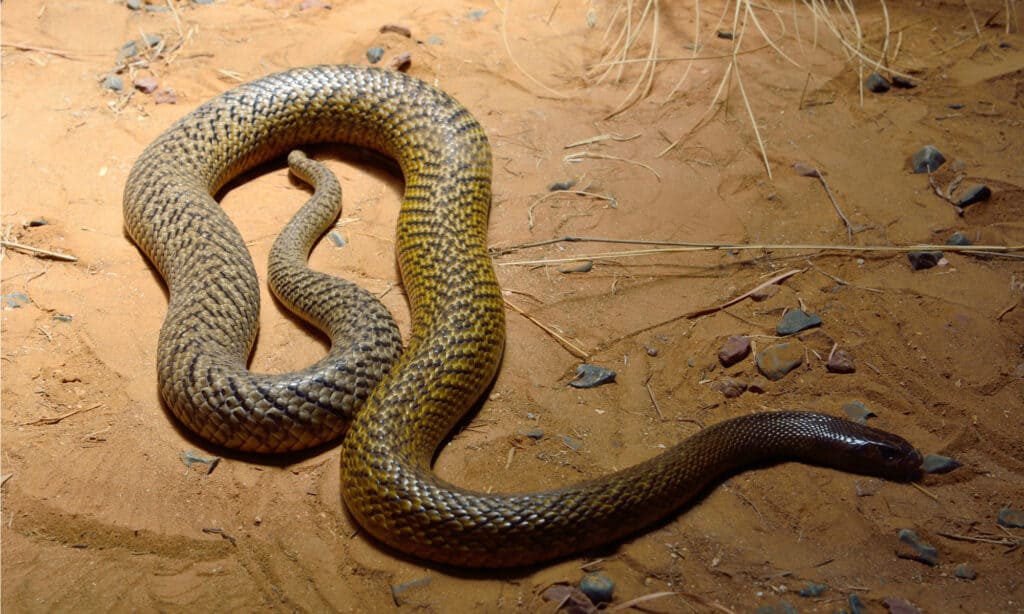
Beerwah, Queensland, Australia – December 14, 2017. Inland taipan (Oxyuranus microlepidotus), the most venomous snake in the world, at Australia Zoo.
©Alizada Studios/Shutterstock.com
The queen snake, also sometimes called queen snake, is found only east of the Mississippi River from southern Ontario to northern Florida. Endemic to North America, they thrive in Louisiana, Mississippi, Alabama, Georgia, Florida, Arkansas, Tennessee, North Carolina, South Carolina, West Virginia, Virginia, Maryland, Delaware, Pennsylvania, Indiana, Ohio, Michigan, Illinois, Wisconsin, and New York. Once inhabitants of New Jersey, the snakes have been extirpated from the state. This means they are extinct there.
Their ideal habitat is a watershed, an area that channels precipitation from rain or snow into streams, creeks, lakes, and rivers. These swamps, wetlands, marshes, and other areas also typically have abundant groundwater, trees, and stones that provide hunting grounds and shelter.
The nonvenomous, semiaquatic snakes live beneath large rocks, along tree roots, and even in tree branches where they like to bask in the warm sun. If they are disturbed within their habitat, they will drop from a tree branch into the water below or quickly slither into the water to swim away.
The ideal water temperature for the snakes is a minimum of 50°F (10°C) when they are active in spring, summer, and fall. One of their key adaptations is to enter a state of brumation in the winter months. During this time, they stop growing and developing.
In brumation, they are not physically active and instead enter a den with other queen snakes where they remain dormant until spring. Their hibernacula dens are often under bridges, cracked retaining walls, and other urban niches where they are elevated and stay dry.
Scientific Name
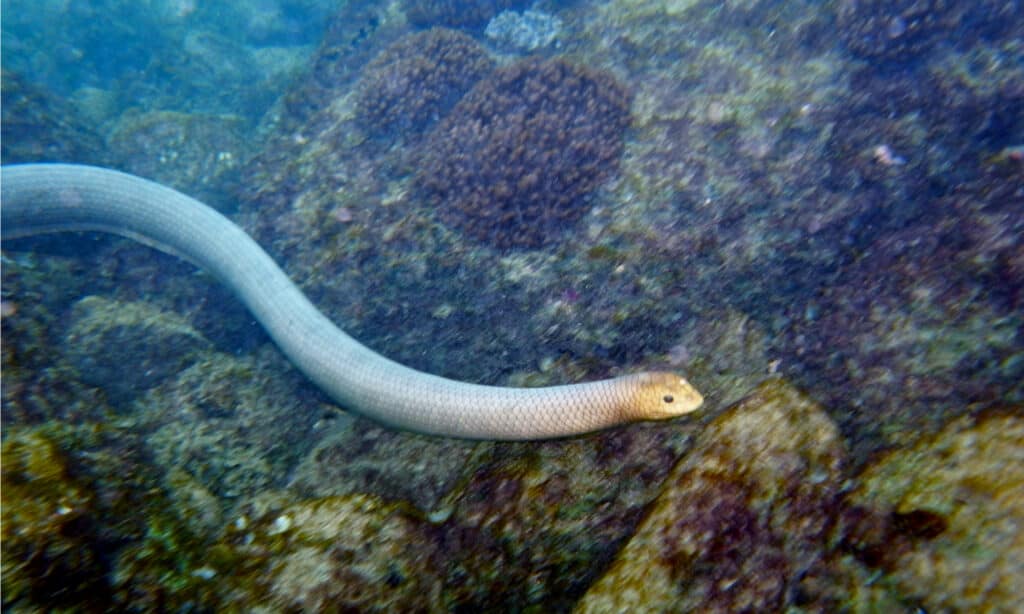
Olive Sea snake, Disteira major in Bundaberg, Great Barrier Reef, Queensland. It can grow up to six feet long and weigh up to six and a half pounds.
©Sahara Frost/Shutterstock.com
The semiaquatic queen snake’s scientific name is Regina septemvittata. Regina comes from the Latin term “regius,” meaning “queen.” The Latin words “septem” and “vitta” make up the specific portion of the scientific name, translating to “seven stripes.” While not all queen snakes have seven stripes, many do have multiple light and dark stripe markings.
Other names for Regina septemvittata vary according to the region where the snakes are found. Some of these names include the moon snake, pale snake, leather snake, olive water snake, banded water snake, diamond-back water snake, North American seven-banded snake, striped water snake, willow snake, and yellow-bellied snake.
Conservation Status
According to the IUCN Red List of Threatened Species, the queen snake’s conservation status is of least concern. The population is stable and thriving in their native North American region east of the Mississippi River. The adult population size is reported by the IUCN to be more than 100,000 queen snakes.
Appearance and Description
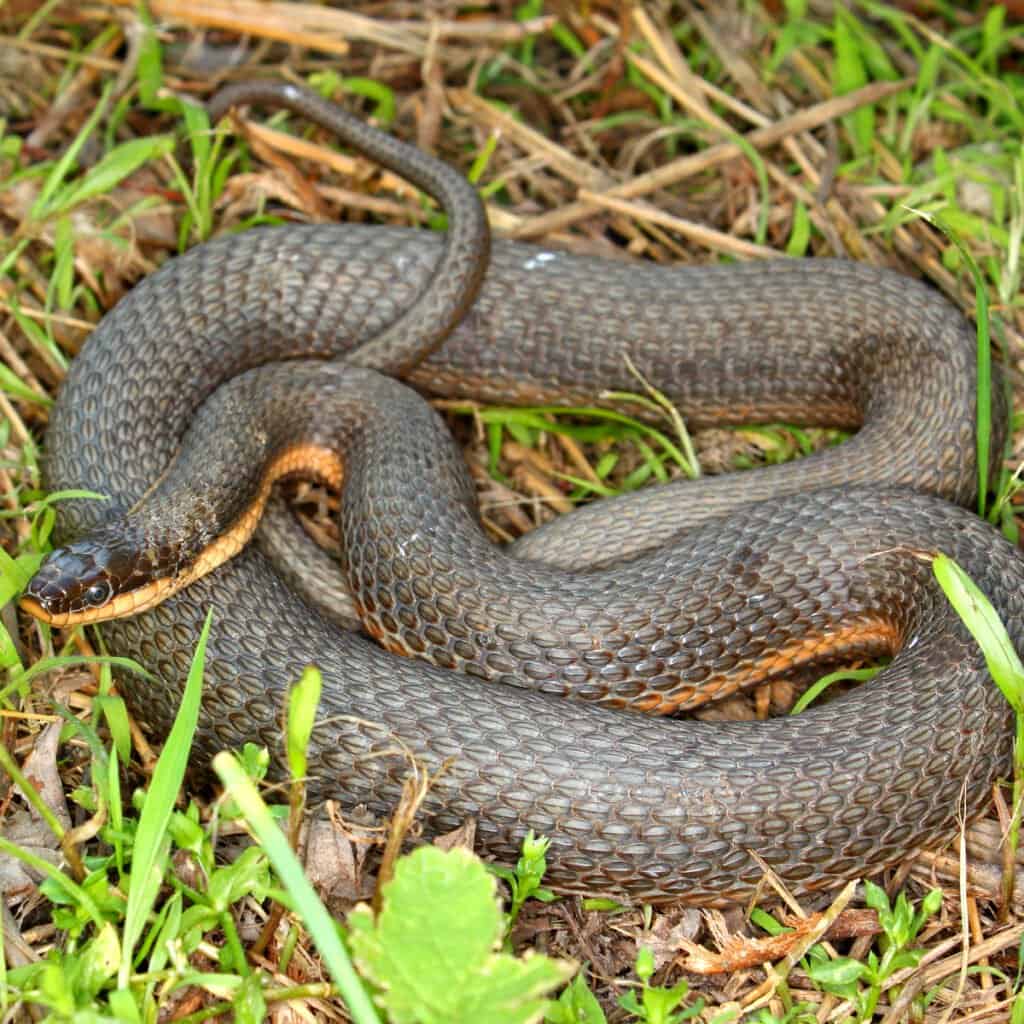
The queen snake is a non aggressive, non venomous snake found in North America
©Jason Patrick Ross/Shutterstock.com
Queen snakes look and behave much like garter snakes, another North American nonvenomous species from the genus Thamnophis in the family Colubridae. Most queen snakes are olive green, gray, or dark brown overall. They typically have yellow or peach stripes from their first row of scales to the tip of the tail. With these lighter stripes are four darker ones. In fact, the queen snake is the only one of its type and region that has stripes running lengthwise on its belly, making it easy to identify.
Young queen snakes have three more stripes than adults, giving them a total of seven. Three of these are on their backs and four are on their bellies. These fade away as they mature. The seven stripes of the young are those from which it gets its “septemvittata” taxonomy name which means “seven stripes.” With its striping on the belly, the snake’s underside is typically cream or yellow in color.
The queen snake’s head is narrow with nine primary scales on its top. Thicker scales in multiple rows beneath the chin are adaptations that protect them from abrasion when they chase prey beneath rocks. Together, the head’s top and chin scales help prevent crushing when slithering beneath heavy rocks. Their pupils are rounded. Females are usually a bit bigger than males. The longest of the species typically measures no more than 24 inches from nose to tail tip.
How to identify queen snakes:
- Olive green, gray, or dark brown body
- Up to seven body-colored, peach or yellow stripes from the base of the head to the tail
- Stripes on the belly as well as the back
- Round pupils
- The average length of up to 24 inches long
- Nine scales on a narrow head
- Multiple rows of thicker scales under the chin
How Dangerous Are They?
Queen snakes are nonvenomous. They also rarely bite and are easily handled if caught, offering no danger to humans. The reptile’s best defenses are dropping from trees into the water, swimming swiftly away from the threat, and remaining out of sight. But if they are picked up by a human or other animal, like the garter snake they release foul-smelling feces or anal musk.
Behavior and Humans
Queen snakes are nonvenomous, not dangerous, and very timid, particularly around humans. They are also not a pest because they play a vital role in controlling the crayfish population. In fact, crayfish make up about 90% of the snake’s daily diet. The snake hunts these freshwater crustaceans using a keen sense of smell. They target the shelled creatures when they are molting and their soft bodies are left exposed. Also because the crayfish prey is typically molting when pursued, they cannot easily injure the snake in defense.
Queen snakes also eat tadpoles, frogs, minnows, snails, newts, and fairy shrimp. At the same time, they provide a vital food source for larger predators like herons, hawks, mink, otters, and raccoons. Sometimes a crayfish with its shell intact will hunt and eat baby queen snakes! These babies are born live and fully independent from the start, also making them vulnerable to being attacked.
The semiaquatic snake typically lives at or near the water’s edge in its habitat. They are frequently seen sunning on branches or even hanging from limbs in the daytime. If startled, the snake will drop into the water to swim to safety. Being diurnal, the snake is most active in the daytime and sleeps at night. But they will occasionally come out at night for hunting or another movement. In winter, they gather under bridges, large rocks, urban structures, and other elevated, dry shelters for brumation until spring.
Humans often keep queen snakes as pets because this species does not typically bite and has a lengthy lifespan of over 10 years when well managed. It is nonvenomous and poses no real threat to people. However, one of the snake’s key adaptations is a defense reflex of discharging foul-smelling secretions from its anus. This is similar to the defense mechanism of a garter snake. To prevent this issue, the pet owner only needs to approach their snake’s handling slowly and without startling the reptile.
View all 8 animals that start with QQueen Snake FAQs (Frequently Asked Questions)
Are queen snakes venomous?
Queen snakes are nonvenomous and rarely bite humans. In fact, they are docile, easy to handle and make great pets.
How do queen snakes hunt?
These snakes rely on their keen sense of smell to hunt their prey, primarily targeting molting crayfish. They hunt mostly during the daytime but will sometimes do so at night.
Are queen snakes aggressive?
Queen snakes are timid and docile, particularly around humans and predatory animals. Because they are nonvenomous and do not have a powerful bite, their only defenses are to swim swiftly away from the threat or otherwise leave the area. They also emit a foul-smelling discharge or feces when grabbed, much like the garter snake.
Where do queen snakes live?
Queen snakes live in almost every state east of the Mississippi River in the United States. They also live in southern Ontario, Canada. They are endemic to North America and maintain healthy populations in their native habitats.
What do queen snakes eat?
About 90% of the queen snake diet is made up of molting crayfish. But they also eat tadpoles, frogs, minnows, snails, newts and fairy shrimp from within their freshwater habitat.
Why is the queen snake important?
The queen snake is not a pest, in any sense of the word. They are vital in controlling the crayfish population. At the same time, they provide a vital food source for animals like raccoons, herons, hawks, mink and otters.
How did the queen snake get its name?
To this day, no one knows why the queen snake was bestowed with a name of royalty. But the common term “queen” comes from the snake’s Latin scientific name, Regina septemvittata. Regina translates to “queen” and septemvittata means “seven stripes.”
Thank you for reading! Have some feedback for us? Contact the AZ Animals editorial team.
Sources
- , Available here: https://en.wikipedia.org/wiki/Queen_snake
- , Available here: https://srelherp.uga.edu/snakes/regsep.htm
- , Available here: http://www.biokids.umich.edu/critters/Regina_septemvittata/
- , Available here: https://www.dec.ny.gov/animals/79586.html
- , Available here: https://herpsofnc.org/queen-snake/
- , Available here: https://mnfi.anr.msu.edu/species/description/11511/Regina-septemvittata
- , Available here: https://snake-facts.weebly.com/queen-snake.html
- , Available here: https://www.floridamuseum.ufl.edu/florida-snake-id/snake/queensnake/
- , Available here: https://www.tn.gov/twra/wildlife/reptiles/snakes/queen-snake.html
- , Available here: https://www.natureconservancy.ca/en/what-we-do/resource-centre/featured-species/reptiles-and-amphibians/queen-snake.html
- , Available here: https://happyserpent.com/snake-profile/queen-snake/
- , Available here: http://www.conservewildlifenj.org/species/fieldguide/view/Regina%20septemvittata/
- , Available here: https://www.reconnectwithnature.org/news-events/the-buzz/creature-feature-the-royal-queen-snake
- , Available here: https://oepos.ca.uky.edu/content/queen-snake
- , Available here: https://www.virginiaherpetologicalsociety.com/reptiles/snakes/queen-snake/queen_snake.php
- , Available here: https://www.virginiaherpetologicalsociety.com/reptiles/snakes/queen-snake/queen_snake.php
- , Available here: https://www.inaturalist.org/guide_taxa/393431
- , Available here: https://reptile-database.reptarium.cz/species?genus=Regina&species=septemvittata
- , Available here: https://eol.org/pages/790829
- , Available here: https://www.marshall.edu/herp/Old/queensnake.htm
- , Available here: http://www.basic.ncsu.edu/ncgap/sppreport/aradb27040.html
- , Available here: https://undergroundreptiles.com/product/queen-snake/
- , Available here: https://dnr.wi.gov/topic/EndangeredResources/Animals.asp?mode=detail&SpecCode=ARADB27040
- , Available here: http://www.neoperceptions.com/snakesandfrogs.com/scra/snakes/queensn.htm
- , Available here: https://www.discoverlife.org/mp/20q?search=Regina+septemvittata&guide=Snakes
- , Available here: https://www.iucnredlist.org/species/63887/12717768
- (1970) https://oceanservice.noaa.gov/facts/watershed.html Jump to top

